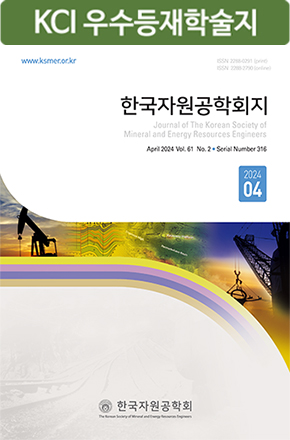- 송원경, 허승, 김태혁, 2008, “GIS 기법을 이용한 광미댐 수문 분석,” 터널과 지하공간(한국암반공학회지), 제18권 5호, pp. 375-385.
- 이동길, 송원경, 정영욱, 정명채, 임길재, 윤석호, 권현호, 2008, “광미적치장의 최적 처리방안 선정을 위한 경제성 분석 연구,” 한국지구시스템공학회지, 제45권 6호, pp. 663-672.
- 최요순, 선우춘, 박형동, 2006, “광해방지를 위한 대규모 석 탄 노천광의 배수설계 최적화,” 한국지구시스템공학회지, 제43권 5호, pp. 429-438.
- 최요순, 오승찬, 박형동, 권현호, 윤석호, 고와라, 2009, “폐탄광 지역 산림훼손지 복구를 위한 GIS 기반의 의사결정 지원시스템 개발,” 한국지구시스템공학회지, 제46권 6호, pp. 691-702.
- 최요순, 박형동, 2011, “대규모 노천광산의 채굴적 하단 저수지 설계를 위한 GIS 모델링,” 한국지구시스템공학회지, 제48권 2호, pp. 165-177.
- 홍창선, 백경원, 심우배, 2002, 수문학, 일진사, 서울, pp. 196-198.
- Choi, Y., Park, H.D. and Sunwoo, C., 2008, “Flood and gully erosion problems at the Pasir open pit coal mine, Indonesia: a case study of the hydrology using GIS,” Bulletin of Engineering Geology and the Environment, Vol. 67, No. 2, pp. 251-258.
- Choi, Y., Yi, H. and Park, H.D., 2011, “A new algorithm for grid-based hydrologic analysis by incorporating stormwater infrastructure,“ Computers & Geosciences, Vol. 37, No. 8, pp. 1035-1044.
- Costa-Cabral, M.C. and Burges, S.J., 1994, “Digital elevation model networks (DEMON): A model of flow over hillslopes for computation of contributing and dispersal areas,” Water Resources Research, Vol. 30, No. 6, pp. 1681-1692.
- Desmet, P.J.J. and Govers, G., 1996, “Comparison of routing algorithms for digital elevation models and their implications for predicting ephemeral gullies,” International Journal of Geographical Information Systems, Vol. 10, No. 3, pp. 311-331.
- Duke, G.D., Kienzle, S.W., Johnson, D.L. and Byrne, J.M., 2003, “Improving overland flow routing by incorporating ancillary road data into Digital Elevation Models,” Journal of Spatial Hydrology, Vol. 3, No. 2, pp. 1-27.
- Duke, G.D., Kienzle, S.W., Johnson, D.L. and Byrne, J.M., 2006, “Incorporating ancillary data to refine anthropogenically modified overland flow paths,” Hydrological Processes, Vol. 20, No. 8, pp. 1827-1843.
- Fairfield, J. and Leymarie, P., 1991, “Drainage networks from grid digital elevation models,” Water Resources Research, Vol 27, No. 5, pp. 709-717. Freeman, T.G., 1991, “Calculating catchment area with divergent flow based on a regular grid,” Computers & Geosciences, Vol. 17, No. 3, pp. 413-422.
- Garbrecht, J. and Martz, L.W., 1997, “The assignment of drainage direction over flat surfaces in raster digital elevation models,” Journal of Hydrology, Vol. 193, No. 1-4, pp. 204-213.
- Holmgren, P., 1994, “Multiple flow direction algorithms for runoff modelling in grid based elevation models: an empirical evaluation,” Hydrological Processes, Vol. 8, No. 4, pp. 327-334.
- Martz, L.W. and Garbrecht, J., 1992, “Numerical definition of drainage network and sub-catchment areas from Digital Elevation Models,” Computers & Geosciences, Vol. 18, No. 6, pp. 747-761.
- O’Callaghan, J.F. and Mark, D.M., 1984, “The extraction of drainage networks from digital elevation data,” Computer Vision, Graphics, and Image Processing, Vol. 28, No. 3, pp. 323-344.
- Orlandini, S., Moretti, G., Franchini, M., Aldighieri, B. and Testa, B., 2003, “Path-based methods for the determination of nondispersive drainage directions in grid-based digital elevation models,” Water Resources Research, Vol. 39, No. 6, p. 1144.
- Qin, C., Zhu, A.-X., Pei, T., Li, B., Zhou, C. and Yang, L., 2007, “An adaptive approach to selecting a flow-partition exponent for a multiple-flow-direction algorithm,” International Journal of Geographical Information Science, Vol. 21, No. 4, pp. 443-458.
- Quinn, P., Beven, K., Chevallier, P. and Planchon, O., 1991, “The prediction of hillslope flow paths for distributed hydrological modelling using digital terrain models,” Hydrological Processes, Vol. 5, No. 1, pp. 59-79.
- Tarboton, D.G., 1997, “A new method for the determination of flow directions and upslope areas in grid digital elevation models,” Water Resources Research, Vol. 33, No. 2, pp. 309-319.
- Tribe, A., 1992, “Automated recognition of valley lines and drainage networks from grid digital elevation models : a review and a new method,” Journal of Hydrology, Vol. 139, No. 1-4, pp. 263-293.
- Publisher :The Korean Society of Mineral and Energy Resources Engineers
- Publisher(Ko) :한국자원공학회
- Journal Title :Journal of the Korean Society for Geosystem Engineering
- Journal Title(Ko) :한국지구시스템공학회지
- Volume : 48
- No :5
- Pages :549-559



 Journal of the Korean Society of Mineral and Energy Resources Engineers
Journal of the Korean Society of Mineral and Energy Resources Engineers








